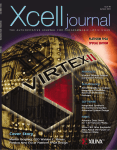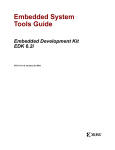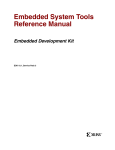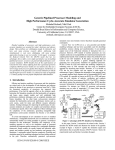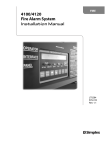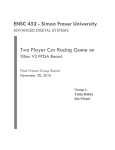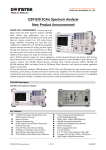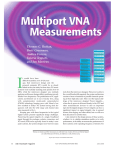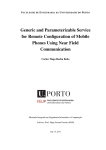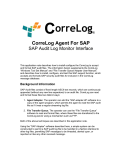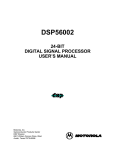Download as a PDF - CECS - University of California, Irvine
Transcript
Processor Customization on a Xilinx Multimedia Board Partha Biswas, Sudarshan Banerjee, and Nikil Dutt, CECS Technical Report #06-04 Center for Embedded Computer Systems School of Information and Computer Science University of California, Irvine, CA 92697, USA Mar 12, 2006 Abstract Performance of applications can be boosted by executing application-specific Instruction Set Extensions (ISEs) on a specialized hardware coupled with a processor core. Many commercially available customizable processors have communication overheads in their interface with the specialized hardware. However, existing ISE generation approaches have not considered customizable processors that have communication overheads at their interface. Furthermore, they have not characterized the energy benefits of such ISEs. This report presents a soft-processor customization framework that takes an input ‘C’ application and realizes a customized processor capturing the microarchitectural details of its interface with the specialized unit. The speedup, energy, power and code size benefits of the ISE approach were accurately evaluated on a real system implementation by applying the design flow to a popular Xilinx Microblaze soft-processor core synthesized for four real-life applications. It was found that only one large ISE per application is sufficient to get an average 1.41× speedup over pure software execution in spite of incurring communication overheads. Finally, a simultaneous savings in energy (up to 40%) and power (up to 12% peak power reduction) with this increased performance were observed. 1 Contents 1 Introduction 4 2 Customized Processor Model 5 3 Related Work 5 4 Framework for Complete System Realization 4.1 Preprocessing Input Application . . . . . 4.2 ISE Generation Phase . . . . . . . . . . . 4.3 H/W Generation Phase . . . . . . . . . . 4.4 S/W Generation Phase . . . . . . . . . . 4.5 Processor Subsystem Generation Phase . . . . . . . . . . . . . . . . . . . . . . . . . . . . . . . . . . . . . . . . . . . . . . . . . . . . . . . . . . . . . . . . . . . . . . . . . . . . . . . . . . . . . . . . . . . . . . . . . . . . . . . . . . . . . . . . . . . . . . . . . . . . . . . . . . . 6 7 7 7 8 10 5 Communication Template for Xilinx Microblaze 11 6 Experiments 12 6.1 Experimental Setup . . . . . . . . . . . . . . . . . . . . . . . . . . . . . . . . . . . . . . 12 6.2 System Implementation on the Board . . . . . . . . . . . . . . . . . . . . . . . . . . . . . 13 7 Experimental Results 13 7.1 Performance and Code Size . . . . . . . . . . . . . . . . . . . . . . . . . . . . . . . . . . 13 7.2 Power and Energy Results . . . . . . . . . . . . . . . . . . . . . . . . . . . . . . . . . . 15 7.3 Slices Utilization . . . . . . . . . . . . . . . . . . . . . . . . . . . . . . . . . . . . . . . 16 8 Summary and Future Directions 16 A System Realization on Xilinx Multimedia Board 18 B Steps for System Simulation using ModelSim 21 C Creating a Custom FSL Interface 26 D VHDL Source for the Communication Template 26 E Structural AFU model for adpcm-d 29 F AFU with its Interface for adpcm-d 36 List of Figures 1 2 3 Target Customized Processor Subsystem . . . . . . . . . . . . . . . . . . . . . . . . . . The Flow of our Framework . . . . . . . . . . . . . . . . . . . . . . . . . . . . . . . . . (a) A high-level application to a hardware/software system generation (b) Processor subsystem generation . . . . . . . . . . . . . . . . . . . . . . . . . . . . . . . . . . . . . . . 5 6 8 4 5 6 7 8 9 10 The ISE here is composed of the shaded instruction nodes. (a) An example showing the LastDef point and the FirstUse point; (b1) an example where it is not possible to insert the ISE under consideration; (b2) After code restructuring; (b3) positioning of the ISE between LastDef and FirstUse. . . . . . . . . . . . . . . . . . . . . . . . . . . . . . . . Measuring System Power . . . . . . . . . . . . . . . . . . . . . . . . . . . . . . . . . A DP-external AFU Interface . . . . . . . . . . . . . . . . . . . . . . . . . . . . . . . Microblaze Processor Core with an AFU and its Interface. . . . . . . . . . . . . . . . . Communication Template for AFU Interface in Microblaze . . . . . . . . . . . . . . . . Xilinx Multimedia Board . . . . . . . . . . . . . . . . . . . . . . . . . . . . . . . . . . An ISE for ADPCM ENCODER (adpcm-e) having 4 inputs and 2 outputs; each operation node maps to a hardware component. . . . . . . . . . . . . . . . . . . . . . . . . . . . . . . . . . 9 10 10 11 12 13 . 15 1 Introduction Typically, applications running on a programmable platform can be executed either as a software algorithm or on a specialized hardware unit. The software approach is the slowest but most flexible while the hardware approach is the fastest but least flexible. Instruction Set(IS)-extensible processors comprise an emerging class of processors (especially in the embedded domain) that permit execution of only the critical application kernels in customized units (as hardware) with the rest of the application executing on the processor core (as software). This speeds up the application without compromising the processor clock or modifying the architectural model of the processor and yet preserves the flexibility of the software approach. We call such a coprocessing hardware element an Ad-hoc Functional Unit (AFU). The AFU operation is triggered by an instruction or a set of instructions that we call an Instruction Set Extension or ISE. In the past, researchers have modeled AFUs having no communication overhead. However, many commercially popular customizable processors have communication overheads in their interface with AFUs. Therefore, our goal is to consider the microarchitectural details of an AFU interface in a processor customization framework and accurately evaluate the performance and energy benefits of ISEs in a realistic processor. The efficacy of the framework lies in seamlessly considering the synchronization between the processor and the AFU in a unified manner for different applications. Minimizing power and energy consumption is as important as maximizing performance in embedded systems. A high power consumption may destroy a chip completely through overheating while a high energy consumption may reduce the battery life of an embedded device. Therefore, even though ISEs can achieve high speedups, designers need to determine if this speedup comes at a price of increased power. This report shows that increased performance can also reduce both power and energy of a customizable processor in the presence of an AFU and reports the effects on code size and area. It is predicted [17] that by 2010, over one-third of all PLD/FPGA devices are expected to have microprocessor cores, up from 15% today. Xilinx Microblaze [10] is a popular commercially-available soft-core. We demonstrate the use of our framework by transforming a given input application into a running Xilinx Microblaze hardware-software system. For four real-life applications (from Mediabench and EEMBC suites), we measure the real performance gain over pure software execution and also accurately evaluate energy and power consumption. Our experimental results show that significant speedup is obtained only when an ISE contains a large set of atomic operations. With only one large ISE per application, we obtained speedup of up to 1.47× over simple software execution and simultaneously up to 40% energy saving and 12% peak power reduction. To the best of our knowledge, this is also the first attempt to present the details of interfacing an AFU with a customizable soft-core. The main contributions highlighted in this report are the following: • We present a generalized interface-aware soft-processor customization framework for mapping an application in C into a running processor-AFU subsystem that enables accurate evaluation of all the metrics deemed important in embedded system design, namely, performance, energy, power, cost and code size. • By applying our framework to Microblaze soft-processor core, we conclude that ISEs can be simultaneously beneficial in terms of performance, energy, power and code size. The rest of the report is organized as follows. We present our target customizable processor model in Section 2. In Section 3, we present some related research work. We describe our framework for transforming a given application to a customized processor subsystem in Section ??. Section 6.1 presents Processor Subsystem Program Memory Core DP−external Register File Data Memory Bus External Tightly−coupled Execution Unit AFU AFU External DP−internal Interface Tightly−coupled Peripherals Interface Decoder AFU Coprocessor Loosely−coupled External Memory Figure 1. Target Customized Processor Subsystem how we use the framework to target Xilinx Microblaze soft-processor core. In Section ??, we describe our experimental results. Finally, Section 8 concludes the report. 2 Customized Processor Model Our goal is to map a given application to the target customizable processor model shown in Figure 1. In this model, the software part of the application stored in the program memory is composed of base instructions to be run on Execution Unit and ISEs to be run on the hardware part, i.e., AFUs. An AFU can be tightly-coupled with the core through an AFU interface inside the processor subsystem or loosely-coupled through an external bus. The AFU interface or the external interface implements the communication protocol between the AFU and the processor and thus controls synchronization of data and access to the processor register file. The function of an ISE is to transfer control to an AFU for execution. An ISE can be either a single user-defined instruction or a set of multiple pre-defined instructions. A single user-defined instruction is decoded as a special instruction, which encapsulates inputs and outputs of an AFU as source and destination operands respectively. The decoder takes the responsibility of issuing such a special instruction to an appropriate AFU for execution. Alternatively, sending inputs and receiving outputs of the AFU from the processor can be done at the expense of multiple data transfer instructions. Such instructions must already exist in the instruction set of the processor in the form of “send data to AFU” and “receive data from AFU” instructions. In this case, the AFU incurs communication overhead at its interface while sending and receiving data. 3 Related Work Several algorithms [1, 4, 2, 3, 5, 6] have recently been proposed to identify ISEs in a given application. The speedups over simple software execution claimed in most of the approaches [1, 4, 2, 3] are estimated by assuming a typical RISC processor execution model. The methodology in [5] targets Trimaran research infrastructure. Using a simulator, the authors show speedup for applications that reuse AFUs generated for other applications in the same domain. Such reuse of AFUs across application is possible only when ISEs found were reasonably small in size. However, we will confirm in our experimental results that such small-sized ISEs would not generate a considerable speedup for AFUs with communication overheads. Sun et al. [6] employs a Tensilica Instruction Extension (TIE) compiler in their methodology and operates at a higher (C source-code) level of abstraction. Therefore, this methodology relies more on designer’s experience for ISE identification and mapping to AFUs. The AFU in this case therefore does not have any communication overhead. Fei et al. [7] integrated a fairly accurate energy estimation engine in the same framework, but they do not report a comparison of energy before and after extending the processor. A recent work having a goal of real system implementation [8] generated application-specific instructions for Altera Nios II processor in the presence of AFUs that do not have communication overheads. The results show a good speedup and limited area overhead, but they do not discuss energy or power consumption. Unlike [8], in this report, we deal with the non-trivial details of synchronization between the processor and the AFU with the help of a generic communication template. Note that in the prior related work, the AFU in general did not have communication overheads at its interface. Indeed, there are many commercially available processors providing such an interface. Common examples are Altera Nios II processor [13], LEON processor [12], etc. However, there are similarly many commercial customizable processors where AFUs incur overhead in sending and retrieving data. Some examples include STMicroelectronics ST120 [11], Xilinx Microblaze processor [10], etc. To the best of our knowledge, ISE generation in the context of AFUs incurring communication overheads at their interface with the core processor has not been studied yet. This is our motivation for proposing a framework that is capable of incorporating different AFU models and in particular, targeting Xilinx Microblaze soft-core. We apply the design flow of our framework to study performance gain, energy/power consumption, code size reduction and area overhead with the introduction of an AFU into the Microblaze subsystem. 4 Framework for Complete System Realization Our framework takes as input a high-level application (in C), and generates an executable and an AFU with appropriate interfacing protocol (as shown in Figure 2). The executable runs in the processor core as software containing ISEs for invoking the AFU operation in hardware. Our target for running the complete processor-AFU subsystem is an FPGA platform. Application ISE Generation ISEs Latency S/W Generation H/W Generation Interface Executable System Processor Core AFU+Interface AFU FPGA platform Figure 2. The Flow of our Framework The expanded view of our framework is shown in Figure 3(a). It has five main phases: Preprocessing phase, ISE generation phase, S/W generation phase, H/W generation phase, and Processor subsystem generation phase. The Preprocessing phase takes the input application and generates an annotated intermediate representation. The ISE generation phase generates ISEs under microarchitectural constraints. The H/W generation phase synthesizes the corresponding AFUs with their interfaces and the S/W generation phase generates the executable. A dotted arrow between the two phases indicates that the latency of an ISE obtained in the H/W generation phase is passed on to the S/W generation phase. Finally, the Processor subsystem generation phase builds the complete running system for evaluation. 4.1 Preprocessing Input Application This phase can be identified as a box labeled “Preprocessing” in Figure 3(a). A compiler front-end yields Control Flow Graph (CFG) and Data Flow Graph(DFG) of an input application and runs predication to combine a set of small basic blocks into a large basic block. The input application is then profiled and the basic blocks are annotated with their execution counts. A component library is created containing a synthesizable combinational element corresponding to each instruction in the target instruction set. Each element in the library is synthesized for a given technology and the corresponding instruction in the DFG is annotated with a normalized hardware latency. Each instruction in the DFG is also annotated with its software latency obtained from the target architecture specification. 4.2 ISE Generation Phase This phase (shown as the “ISE generation” box in Figure 3(a)) is integrated with the compiler frontend. An ISE generation algorithm takes the annotated CFG/DFG and returns subgraphs or ISEs that would maximize performance under microarchitectural constraints. Although any ISE generation algorithm can be used, we use ISEGEN in our framework because it identifies all the instances of an ISE exploiting large-scale ISE reuse. 4.3 H/W Generation Phase We show this phase in a box marked “H/W generation” in Figure 3(a). The two subtasks of this phase are component library binding and interface synthesis. The identified subgraph or ISE is isolated and each instruction in the subgraph is replaced by the corresponding element in the component library. Figure 10 shows an example subgraph where each node maps to an element in the component library. The data dependencies between the instructions are replaced by port-to-port connections between the elements and the resulting structure is an AFU. This structural AFU model is then synthesized to evaluate the critical path length. The critical path length divided by the clock period of the processor core gives the number of cycles needed for the AFU operation. This latency information is passed on to the scheduler in the S/W generation phase (shown with a dotted arrow in Figure 3). The evaluated number of cycles is also used to synchronize the AFU with respect to the core. Apart from the component library, the designer also creates a communication template for AFUs, which captures the communication protocol between the processor core and the AFU. The writing back of result from the AFU to the processor is delayed by the exact number of cycles required by the AFU operation. The implementation of communication protocol together with synchronization with the core completes the AFU interface synthesis. Note that the H/W generation phase can be applied to synthesize the AFU and its interface in the customized processor model presented in Figure 1. Application Preprocessing Compiler Front-end Profile code CFG/DFG Annotate w/ hw/sw latencies, exec count S/W generation ISE generation Replace subgraph by ISE Component Library Constraints Communication Template Annotated CFG/DFG CFG/DFG w/ ISEs ISEGEN Scheduling Register Alloc ISEs or subgraphs Compiler Back-end H/W generation Component Library Binding Replace ops by components and edges by cnxns Executable Clock Period Interface Synthesis Structural AFU model Eval Crit. Path Calc # Cycles Couple Computation w/ Communication AFU + Interface # Cycles Latency (a) AFU + Interface Processor model Synthesis P/R Processor Subsystem generation System (b) Figure 3. (a) A high-level application to a hardware/software system generation (b) Processor subsystem generation 4.4 S/W Generation Phase This phase (shown in Figure 3(a) as a box titled “S/W generation”) generates code for the target processor taking into account the presence of AFUs. The two subtasks in the S/W generation phase are subgraph matching and subgraph replacement with ISEs. Since all possible instances of an ISE have already been enumerated by the ISE generation phase, the subgraph matching simply consists of a DFG traversal and marking constituent instructions of the ISE in the DFG. 1 LastDef 2 3 FirstUse 1 1 3 2 FirstUse 3 LastDef 1 3 LastDef 2 FirstUse 4 4 4 4 2 5 5 5 5 (a) (b1) (b2) (b3) Figure 4. The ISE here is composed of the shaded instruction nodes. (a) An example showing the LastDef point and the FirstUse point; (b1) an example where it is not possible to insert the ISE under consideration; (b2) After code restructuring; (b3) positioning of the ISE between LastDef and FirstUse. After subgraph matching, the ISE is used to replace the set of marked instructions in the DFG. We depict the ISE replacement strategy in Figure 4. An ISE can be placed anywhere between the point where its source operands have their last definition (LastDef) and the point where its destination operand has its first use (FirstUse) as shown in Figure 4(a) (the shaded nodes identify the ISE under consideration). Since ISE generation phase has ensured convexity of the identified subgraphs, it is never possible to have a dependency edge from the FirstUse node to the LastDef node because this would make the subgraph non-convex. Consequently, it is possible to encounter a situation where a FirstUse point precedes a LastDef point in the instruction sequence. This renders the subgraph replacement impossible without code restructuring. Consider the following sequence of operations in instruction order: (1)a = b ∗ c; (2)f = a|0x2; (3)e = 5; (4)d = a + e; (5)g = e − d. Suppose the ISE under consideration is a multiply followed by an add, as identified by the nodes labeled 1 and 4 in Figure 4(b1) respectively. Figure 4(b1-b3) show an example of how the placement of ISE between LastDef and FirstUse is accomplished through code restructuring. Since in this case the FirstUse point appears earlier in the instruction chain than the LastDef point, the ISE cannot be placed anywhere (Figure 4(b1)). So, instruction reordering has to be done in order that the LastDef point precedes the FirstUse point. This reordering is possible because there is no dependency from FirstUse to LastDef. Figure 4(b2) shows the code snippet after restructuring Figure 4(b1) (i.e., swapping the positions of node 2 and node 3) and Figure 4(b3) shows the placement of ISE between the LastDef point (node 3) and the FirstUse point (node 2). If an ISE is used as a single user-defined instruction, a single instruction just replaces the set of constituent instructions. Replacing the multiply and the add with a single user-defined instruction (ISE1(·, ·, ·)), the resulting instruction sequence (as in Figure 4(b3)) would become: (3) e = 5; (1),(4) d = ISE1(b, c, e); (2) f = a|0x2; (5) g = e − d. However, if an ISE is represented as a set of predefined data transfer instructions (send(·), receive(·)), the resulting instruction sequence after ISE replacement would appear as: (3) e = 5; (1),(4) send(b); send(c); send(e); receive(d); (2) f = a|0x2; (5) g = e − d. After subgraph replacement with ISE, the compiler performs scheduling, register allocation and target code generation as a back-end pass. Note that the latency of the ISE required by the scheduler is derived Executable Memory Image System Superimpose Structural Model Timing Info Hardware Simulation Routing Info Power Simulation VCD Power Report Figure 5. Measuring System Power from the H/W generation phase as shown in Figure 3(a). 4.5 Processor Subsystem Generation Phase We show this phase in Figure 3(b). As a final step, the processor model of the target Soft-core along with the AFU and its interface are synthesized and implemented using standard synthesis and Placeand-Route tools. The executable generated in Figure 3(a) and the system synthesized in Figure 3(b) are deployed in two schemes, one for measuring speedup and the other for evaluating energy/power consumption. With the goal of measuring actual time spent in running the application, the scheme for Performance Measurement uses the bitmap of the synthesized system to program an FPGA fabric, which then becomes the platform for actually running the executable. The executable is downloaded into the system memory through a JTAG port and the number of cycles for running the executable is measured using a hardware timer. Program Memory Processor Subsystem Core Tightly−coupled Register File Data Memory Bus Interface Execution Unit External AFU External DP−external AFU Interface Decoder Peripherals External Memory Figure 6. A DP-external AFU Interface Since there is no direct way to measure power of a running system on the FPGA fabric, we employ a different scheme for Power/Energy Evaluation (depicted in Figure 5) for accurately evaluating the power and energy consumption of the system. Note that there are three kinds of information in the post- Place-and-Route system (Figure 3(b)): the structural model of the system, the timing information and the routing information. We superimpose the memory image of the executable (in Figure 3(a)) into the memory section of the structural model. This complete structural model along with the timing information is run through a cycle-accurate hardware simulator to generate a Value Change Dump (VCD) of all the signals in the structural netlist. The routing information and the VCD information together are then used by a power simulator to generate the dynamic power consumed at different time steps. We then derive the total energy dissipated in the system from the reported power and the measured execution time. Now, we apply our processor customization framework to generate a real system. 5 Communication Template for Xilinx Microblaze Xilinx Microblaze [10] is a soft-core with a DP-external AFU interface (as shown in Figure 6). We demonstrate the utility of our framework by transforming a given input application into a running Microblaze hardware-software system. Microblaze has a DP-external AFU to be connected with the processor via Fast Simplex Links (or FSLs). FSLs are dedicated point-to-point unidirectional 32-bit wide FIFO interfaces. The Microblaze is capable of including a maximum of 8 input and 8 output FSLs. Counter Count Microblaze Processor FSL 8X8 Cnt_en AFU Int. AFU_en In AFU Out CLK Figure 7. Microblaze Processor Core with an AFU and its Interface. Microblaze is a 32-bit RISC processor with a simple 3-stage pipeline. Figure 7 shows an AFU and its interfacing with the Microblaze processor core via 8 × 8 FSL channels. The AFU interface implements the processor-AFU communication protocol and is synchronous with the Microblaze processor through a global clock (CLK). The AFU interface is also connected to a counter module to enable counting whenever required. If the count enable signal (Cnt en) is ‘1’, counting is enabled. Otherwise, the counter is reset to ‘0’. The signals In[32] and Out[32] are used to send data to and receive data from the AFU respectively. When the AFU-enable signal, AFU en is ‘1’, the AFU latches the output in Out[32]. In Figure 8, we present the generic communication template for Microblaze-AFU interaction as a Finite State Machine (FSM) synchronous with respect to CLK. For the sake of explanation, we call an FSL channel FSL R when it is used for AFU read operation or FSL W when it is used for AFU write operation. Associated with every FSL R channel is a set of three signals, namely, (FSL READ SIG, FSL DATA EXISTS, FSL IN DATA[32]). Another triplet, (FSL WRITE SIG, FSL FIFO FULL, FSL OUT DATA[32]) is associated with every FSL W channel. The FSM is initially in “Input Sync” state waiting for data to arrive on an FSL R channel. When data exists on the FSL channel, the corresponding FSL DATA EXISTS signal goes high causing a transition from “Input Sync” state to “Input Read” state. In “Input Read” state, FSL READ SIG is set to high to cause the data in the FSL R FIFO to be read into (FSL_DATA_EXISTS == ‘low’) (FSL_DATA_EXISTS == ‘high’) Input−Sync Input−Read FSL_READ_SIG <= ‘0’ FSL_READ_SIG <= ‘1’ FSL_WRITE_SIG <= ‘0’ Cnt_en <= ‘0’ In <= FSL_IN_DATA AFU_en <= ‘0’ true true FSL_OUT_DATA <= Out FSL_WRITE_SIG <= ‘1’ FSL_READ_SIG <= ‘0’ AFU_en <= ‘1’ AFU_en <= ‘0’ Cnt_en <= ‘1’ Output−Write Output−Sync (Count == # Cycles) and (FSL_Q_FULL == ‘low’) (Count != # Cycles) or (FSL_Q_FULL == ‘high’) Figure 8. Communication Template for AFU Interface in Microblaze In[32] using a 32-bit signal array, FSL IN DATA. After the data has been read into In[32], the FSM transitions to “Output Sync” state and waits on the AFU operation by enabling the counter. After # Cycles (as evaluated in the H/W generation phase in Figure 3(a)) has elapsed, the result of the AFU operation is latched in Out[32]. If FSL W FIFO is not full (i.e., FSL FIFO FULL is low), a state transition takes place to “Output Write” state. In the “Output Write” state, data from Out[32] is written into the FSL W FIFO using FSL OUT DATA[32] by setting FSL WRITE SIG to high. Thus, for introducing every new AFU, only the AFU module in Figure 7 and the # Cycles change in the process of H/W generation, while the communication template is reused. 6 Experiments We first describe our experiemental setup in detail and then present the experimental results. 6.1 Experimental Setup The ISE generation algorithm (ISEGEN) [1] was integrated with a MACHSUIF [9] front-end. The S/W generation was done with Microblaze GCC-2.95 (mb-gcc) compiler. Microblaze Instruction Set has multiple data-transfer instructions for sending data to and receiving data from its FSL channels — put for sending and get for receiving data in blocking mode, and nput/nget are the corresponding instructions in non-blocking mode. We used the non-blocking send instruction (nput) and the blocking receive instruction (get) for our AFU interface. Because of using two different compilers for ISE generation and S/W generation, the subgraph replacement with ISEs was done as a post-assembly pass on the assembly output of mb-gcc. After replacing the identified subgraphs with ISEs, mb-gcc was run again to generate the executable. We selected four real-life applications for demonstrating the effectiveness of our framework: autcor (Auto-correlation) from EEMBC suite, adpcm-e (ADPCM Encoder) and adpcm-d (ADPCM Decoder) from Mediabench suite, and AES (AES encryption). Our platform is Xilinx Multimedia Board, which is equipped with a Virtex-II XC2V2000 FPGA. Figure 9 shows a snapshot of the board. We used Xilinx Platform Studio for configuring the FPGA to include a Microblaze processor with a 64KB (i.e., the maximum Figure 9. Xilinx Multimedia Board size possible) Block RAM (BRAM), two Local Memory Buses (LMBs) (to interface with BRAM – one for instruction and the other for data), one Microblaze Debugging Manager (MDM) and one Timer (both MDM and Timer on a single On-chip Peripheral Bus (OPB)). The standard inputs and outputs of an application were redirected to the MDM and the elapsed number of cycles was evaluated using the Timer. We set the clock frequency of the Microblaze processor to 50 MHz. The tools used in the second scheme (Figure 5) for evaluating energy and power are ModelSim for hardware simulation [15] and Xilinx XPower for power simulation [16]. We now detail the steps to realize a complete hardware-software subsystem using the Xilinx Multimedia Board. 6.2 System Implementation on the Board The steps that we used to build a Hardware-Software system using Xilinx Embedded Development Kit (EDK) are enumerated in Appendix A. The generated system can be simulated both behaviorally as well as structurally following the steps detailed in Appendix B. Appendix C briefly explains how an AFU is introduced in the form of a user core in the system. 7 Experimental Results We demonstrate the effectiveness of our approach using a number of front-end tools in our framework shown in Figure 3(a). 7.1 Performance and Code Size The code generation for the baseline configuration was done by mb-gcc with all optimizations turned on (-O2, -mnoxl-soft-mul) so that the performance is maximized in pure software execution. The Microblaze configuration was then customized for different applications by introducing AFU with its interface as explained in Section 6.1. The ISEs were generated with I/O constraints of maximum 4 inputs and 2 outputs and number of AFUs set to 1. Note here that for each application, a different Microblaze configuration is generated and the resulting system is analyzed by applying our framework. The results in terms of code size reduction and speedup over software execution are summarized in Table 1. Table 1. Speedup and Code Size Reduction with the Introduction of an AFU having 4 inputs and 2 outputs in the Microblaze subsystem BMs autcor adpcm-d adpcm-e AES Core Only Bytes Cycles 58444 264305 12049 252688 14121 157177 16013 240613 Core + AFU Bytes Cycles 58452 404673 11953 190979 13989 106821 14957 167397 Code Redn -8 96 132 1056 Spdup 0.65× 1.32× 1.47× 1.44× Each of the operand-send and result-receive operations in Microblaze has a latency of 2 cycles. Consequently, the latency for transferring 6 operands is 12 cycles in the worst case and 6 cycles in the best case (i.e., if all the latencies are successfully hidden by the scheduler). The ISE generated for autcor was a chain of just three operations: a multiply, a barrel right shift and an add having software latencies as 3, 2 and 1 cycles respectively. With AFU operation taking just 1 cycle, the best case latency of the ISE is 6 + 1 = 7 cycles. Thus, even the best case performance of the ISE lags behind the worst case performance of the corresponding software execution (3+2+1 = 6 cycles). Consequently, there was slowdown instead of speedup for autcor owing to the communication overhead. However, there are some prior related work [6, 8], which have shown speedup even with small-sized ISEs containing on the order of 3-4 instructions because of incurring no communication overhead in processor-AFU interface. Thus, we confirm that if the AFU interface has a communication overhead, a small-sized ISE will only result in performance degradation. Table 2. Power Benefits of ISEs in the Microblaze subsystem BMs autcor adpcm-d adpcm-e AES Core Only P. Pwr A. Pwr (mW) (mW) 1957 1287 1975 1317 2070 1332 2256 1276 Core + AFU P. Pwr A. Pwr (mW) (mW) 1869 1229 1919 1197 2012 1178 1982 1187 % Pk Pwr Redn 4.5 2.8 2.8 12.1 % Avg Pwr Redn 4.5 9.1 11.6 7.0 The applications adpcm-d and adpcm-e are the two examples where predication of several small critical basic blocks led to a large basic block. Consequently, the ISEs found for these two benchmarks are very large containing on the order of 40 operations. This led to a significant speedup in spite of the communication overhead. Figure 10 shows the ISE of adpcm-e that generated a speedup of 1.47× over pure software execution. The shaded nodes show the inputs and the outputs of the ISE. Appendix D, in2 in1 ’0’ == ’0’ ’8’ 1 0 sel − >= == − in4 in3 0 1 sel in3 ’4’ >> − < 1 0 sel ’3’ 1 0 sel 1 0 sel ’1’ + >> ’2’ − or 1 0 sel 1 0 sel or 1 0 sel or out1 1 sel in2 0 >> + < 1 0 sel − in2 + 0 ’32767’ ’−32768’ ’1’ + ’1’ ’4’ * < 1 sel 0 1 sel 0 1 ’32767’ <= ’−32768’ >= sel out2 Figure 10. An ISE for ADPCM ENCODER (adpcm-e) having 4 inputs and 2 outputs; each operation node maps to a hardware component. Appendix E and Appendix F present the complete VHDL source code for the AFU and its interface for adpcm-d. The last benchmark under consideration is AES, which has the largest number of instructions in its critical basic block. The generated ISE [1] had 8 instances in the critical basic block covering more than 50% of the DFG and overall 12 instances in the critical function. Both the large size and large-scale reuse (as defined in [1]) of the ISE accounts for a significant speedup (1.44×) obtained on AES despite the overhead in sending and receiving operands. Along with the merit of speedup, AES also exhibit a 7% code size reduction owing to replacement of a large chunk of code by an ISE in the form of a set of data transfer instructions. 7.2 Power and Energy Results From Table 2, it is evident that both the peak power (P. Pwr) as well as the average power (A. Pwr) reduced with the introduction of AFU. Because the presence of both core and AFU apparently indicates more circuit activity, an initial expectation is increased power with the addition of AFU. However, because the ISE here is a multi-cycle operation interlocked with the Microblaze pipeline, the AFU operation completely overlaps with a processor pipeline stall. Consequently, we obtain an overall power reduction in the presence of AFU operation owing to reduced overall circuit activity. As shown in Table 3, we also obtained up to 40% saving in energy on account of reduced application runtime. It is interesting to note that the trend of energy decrease (or increase) exactly follows that of speedup (shown again in Table 3 for the sake of comparison). This trend can be expected as a corollary to Table 3. Energy Benefits of ISEs in the Microblaze subsystem BMs autcor adpcm-d adpcm-e AES Tot Energy (µJ) for Core Only 2.21 8.48 10.54 69.09 Tot Energy (µJ) for Core+AFU 3.10 5.84 6.34 43.69 %age Saving -40.27 31.13 39.85 36.76 Spdup 0.65× 1.32× 1.47× 1.44× a consistent power reduction shown in Table 2. Thus, contrary to conventional expectation, enhanced performance simultaneously results in reduced power and energy for the customized Microblaze soft-core. 7.3 Slices Utilization The XC2V2000 FPGA that we use as our target platform has 10752 slices. Table 4 shows the percentage utilization of the FPGA slices before and after introducing the AFU that brought the speedup in Table 1. Table 4. Slices Utilization (out of 10752) in the absence of an AFU and in the presence of an AFU for the four applications in XC2V2000 FPGA BMs Slices Util. No AFU 1274 11% autcor 1609 14% adpcm-d 1804 16% adpcm-e 2226 20% AES 2043 19% Note here that XC2V2000 used here is very small. The largest possible Virtex-II chip, XC2V8000 contains 46592 slices. If the largest FPGA is used instead of XC2V2000, the average slices utilization reduces to only 5%, which is very reasonable. Thus, the area overhead of including an AFU in the Microblaze subsystem is also minimal. 8 Summary and Future Directions Applications can be accelerated in a programmable processor by executing their performance-critical sections in customized Ad-hoc Functional Units (AFUs) as Instruction Set Extensions (ISEs). We presented an interface-aware processor customization framework that enabled us to implement a customizable soft-core microarchitecture capturing the details of interfacing with an AFU. We applied our framework to four real-life applications and realized four different processor configurations. Our results confirmed that in the presence of communication overhead at the processor-AFU interface, significant speedup over pure software execution is possible only if the AFU function is sufficiently larger than a set of 2-3 operations. Further analysis of the synthesized systems led to the conclusion that integration of AFUs in a customizable processor can result in increased performance and reduced code size, while simultaneously decreasing power and energy consumption. Our future work will investigate the advantages of ISEs in other reconfigurable platforms and commercially available processors. References [1] P. Biswas, S. Banerjee, N. Dutt, L. Pozzi and P. Ienne. ISEGEN: Generation of High-Quality Instruction Set Extensions by Iterative Improvement. In Proc. of DATE, 2005. [2] P. Biswas, V. Choudhary, K. Atasu, L. Pozzi, P. Ienne and N. Dutt. Introduction of Local Memory Elements in Instruction Set Extensions. In Proc. of DAC, 2004. [3] K. Atasu, L. Pozzi and P. Ienne. Automatic Application-Specific Instruction-Set Extensions under Microarchitectural Constraints. In Proc. of DAC, 2003. [4] P. Yu and T. Mitra. Scalable Custom Instructions Identification for Instruction-Set Extensible Processors. In Proc. of CASES, 2004. [5] N. Clark, H. Zhong and S. Mahlke. Processor Acceleration through Automated Instruction Set Customization. In Proc. of MICRO, 2003. [6] F. Sun, S. Ravi, A. Raghunathan and N. K. Jha. Synthesis of Custom Processors based on Extensible Platforms. In Proc. of ICCAD, 2002. [7] F. Sun, S. Ravi, A. Raghunathan and N. K. Jha. A Hybrid Energy-Estimation Technique for Extensible Processors. IEEE TCAD, 2004. [8] J. Cong, Y. Fan, G. Han and Z. Zhang. Application-Specific Instruction Generation for Configurable Processor Architectures. In Proc. of FPGA, 2004. [9] Machine SUIF. http://www.eecs.harvard.edu/hube/software/software.html. [10] Microblaze Processor Reference Guide. http://www.xilinx.com/ise/embedded/mb_ ref_guide.pdf. [11] ST100 DSP Core Architecture Overview. http://www.st.com/stonline/prodpres/ dedicate/st100/overview/overview.htm. [12] The Leon Processor User Manual. http://www.ra.informatik.uni-stuttgart.de/ ˜virazela/LP_Project/leon-2.3.7.pdf. [13] The Nios II Processor Reference Handbook. http://www.altera.com/literature/hb/ nios2/n2cpu_nii5v1.pdf [14] SC140 DSP Core Reference Manual. http://www.soc.napier.ac.uk/module.php3? op=getresource&cloaking=no&resourceid=1473119. [15] ModelSim SE datasheet http://www.model.com/products/pdf/datasheets/se. pdf [16] Xilinx XPower Documentation http://toolbox.xilinx.com/docsan/xilinx6/ books/data/docs/dev/dev0089_14.html [17] Panelists peer into future of FPGAs. Article 60407325, EETimes. March 7, 2005. A System Realization on Xilinx Multimedia Board Here we present the detailed steps to realize a basic hardware-software subsystem with the hardware consisting of the Microblaze processor, local memory bus, BRAM, timer and mdm and the software being the Microblaze executable. 1. Invoke Xilinx Platform Studio (XPS) 6.2i (or higher). 2. Click File→New Project→Platform Studio. The settings for Create New Project are as follows: Project File: <Path to work directory>/system.xmp Target Device Architecture: virtex2 Device Size: xc2v2000 Package: ff896 Speed Grade: -6 (default) 3. Click OK and then answer Yes for Do you want to start with an empty MHS File? Then click OK for the comment Project→Add/Edit Cores. 4. Setting up the hardware: Under System tab, right click on System BSP and select Add/Edit Cores .... (a) Add the following peripherals: • microblaze (1) • bram block (1) • lmb bram if cntlr (2) (1 for data; 1 for instruction): Base Address = 0x00000000; High Address = 0x0000ffff (Memory allocated both for data and instruction = 64 KB) • opb mdm (1): Base Address = 0xffff0400; High Address = 0xffff04ff • opb timer (1): Base Address = 0xffff0800; High Address = 0xffff08ff (Note that address ranges chosen are disjoint) (b) Add the following bus connections: • lmb v10 v1 00 a (2): microblaze 0 dlmb (M), lmb bram if cntlr 0 slmb (S), microblaze 0 ilmb (M), lmb bram if cntlr 1 slmb (S) • opb v20 v1 10 b (1): microblaze 0 dopb (M), microblaze 0 iopb (M), opb mdm 0 sopb (S), opb timer 0 sopb (S) (c) All the Clk and Rst ports. All the net names must be sys clk or sys rst corresponding to Clk and Rst ports respectively. (d) The following parameters need to be changed from their default values: • microblaze 0: C DEBUG ENABLED = 1, C USE BARREL = 1 (to use a barrel shifter), C NUMBER OF RD ADDR BRK = 1, C NUMBER OF WR ADDR BRK = 1 • opb mdm 0: C UART WIDTH = 8 • lmb v10 0: C EXT RESET HIGH = 0 • lmb v10 1: C EXT RESET HIGH = 0 • opb v20 0: C EXT RESET HIGH = 0 Click OK to register all the above changes for the hardware. 5. Setting up the software: In the Applications tab, right click on Software Projects and click Add New Project. Give a name to the project and click OK. (a) Right click on Sources and click Add File... Select all the source (*.c) files and click OK. (b) Right click on Headers and click Add File... Select all the header (*.h) files and click OK. (c) Right click on Default: microblaze 0 xmdstub and click to Mark to Initialize BRAM. (d) Right click on Project: <Project name> and click to un-select Mark to Initialize BRAM. (e) Right click on Project: <Project name> and select Set Compiler Options. Under Directories tab, give a suitable path for Output ELF File, for example, <Path to work directory>/output/executable.elf. (If barrel shifter is present in the Microblaze, i.e., if C USE BARREL = 1, then, under the Advanced tab, insert -mxl-barrel-shift in the Program Sources Compiler Options.) 6. Select Project→Software Platform Settings. (a) In the Processor and Driver Parameters tab, change the Current Value of xmdstub peripheral to opb mdm 0. (b) In the Library/OS Parameters tab, change the Current Values of both stdin and stdout to opb mdm 0. 7. Create a User Constraints File in <path to work directory>/data/system.ucf with the following lines (for Xilinx Multimedia Board): NET ”sys clk” LOC = ”AD16”; NET ”sys rst” LOC = ”AH7”; NET ”sys clk” NODELAY; NET ”sys clk” TNM NET=”clk50”; TIMESPEC ”TSclk50”=PERIOD ”clk50” 20 ns HIGH 50%; Note that the pin mapping will alter if the board is different. The clock frequency is selected to be 50 MHz with 50% duty cycle. 8. Synthesizing the hardware (to be carried out by one the following ways): • Using EDK with Xilinx XST (easier option): (a) Run Tools→Generate Netlist. (b) Run Tools→Generate Libraries and BSPs. (c) Run Tools→Update Bitstream. • Using EDK with Synplicity Synplify Pro (if XST license is unavailable): (a) Open Options→Project Options from the XPS menu. Select tab Hierarchy and Flow and make the following changes: i. Change Synthesis Tool to None. ii. Change Implementation Tool Flow to ISE (ProjNav). (b) Run Tools→Export to ProjNav. A directory projnav is created that contains the exported files. Note that if Xilinx Platform Studio has been installed after XST has expired, an error will be reported saying “[ERROR] Unable to set property: Synthesis Tool”. To resolve this error, run a script containing the following in the <Path to work directory>/ directory. sed ’/XST/d’ npl cmdfile > tmpfile mv tmpfile npl cmdfile pjcli -v -f npl cmdfile (c) Invoke (from Windows menu) Xilinx ISE→Project Navigator. (d) Click File→Open Project and open system.npl to be found in the projnav directory. (e) Double-click xc2v2000-6ff896 (to be found under Sources in Project) to open Project Properties. Change the value of Synthesis Tool to Synplify Pro (VHDL/Verilog) and click OK. (f) Make the following changes in system-structure(<path>/system.vhd) (found under xc2v2000-6ff896): i. Comment the lines library UNISIM; and use UNISIM.VCOMPONENTS.ALL; ii. Add the following lines in the beginning: LIBRARY synplify; use synplify.attributes.all; iii. Comment all the attribute statements. For example, “–attribute box type of bram block 0 wrapper: component is ”black box”;” for the component “bram block 0 wrapper”. Instead, introduce for each component, the following lines: “attribute syn black box of <component name>: component is true;” and “attribute syn noprune of <component name>: component is true;”. The attribute statements were pertaining to XST and Synplify Pro would simply ignore them. So, the “black box” constraints are specified in Synplicity syntax. If the system does not have any output, the Synthesis phase would prune all the components. This is prevented by using syn noprune attribute. (g) Right-click on system-structure(<path>/system.vhd) and select Add Source. Find system.ucf in the data directory and click Open to add constraints. (h) Select system-structure(<path>/system.vhd). Double-click Synthesize—Synplify Pro in Processes for Source section to run synthesis. (Alternatively, double-click Generate Programming File directly which includes running synthesis and Place-and-Route.) (i) Double-click Implement Design to perform Place-and-Route of the design. (j) Double-click Generate Programming File to generate the bitmap file. (k) Go back to XPS. Select Tools→Import from ProjNav and import the following files: i. BIT file: <path to work directory>/projnav/system.bit and ii. BMM file: <path to work directory>/implementation/system bd.bmm. (l) From the XPS menu, run Tools→Update Bitstream. 9. Compiling the software: Run Tools→Build All User Applications. Check whether the size of executable.elf is less than 64 KB. (Recall that the memory allocated for both data and instruction was 64 KB) Also note that the maximum usable space in 56 BRAMs is 64 KB. If not, it is not possible to run with only BRAMs. The alternatives are out of the scope of this document. 10. Running the system: (a) Switch on the board and invoke iMPACT from Xilinx ISE→Accessories. (b) Configure devices via Boundary-Scan Mode with Automatically connect to cable and identify Boundary-Scan chain selected. Select appropriate device to program (e.g., xc2v2000 in our case). (c) Right-click on the device and select Assign New Configuration File. Find download.bit in <path to work directory>/implementation/ directory and select Open. (Observe the PROG LED change color from red to green indicating success.) Close the iMPACT window. (d) Create a file xmd.ini in <path to work directory>/ with the following lines: help mbconnect mdm dow mblaze/code/executable.elf rst con (e) From the XPS menu, run Tools→XMD and check the output of running executable.elf (software) on the synthesized hardware. B Steps for System Simulation using ModelSim A complete system simulation is intended for verifying the correctness and generating the Value Change Dump (VCD) for the different signals employed. The correctness is ensured using both the behavioral simulation as well as the structural (Post-Place-and-Route) simulation. The VCD is relevant only after the flattened netlist has been generated. After the VCD dump is generated by the structural simulation run, XPower is employed to evaluate the system in terms of power and energy consumption. The steps required for taking the design from the EDK into the Project Navigator and running the behavioral and structural simulation are as follows: 1. Creating Simulation libraries (a) Compiling Xilinx Simulation Libraries (COMPXLIB): Following are the two ways. • From the Project Navigator: i. Open an existing project (that might have been exported from Xilinx Platform Studio using the Export to ProjNav option) and highlight the target device. ii. In the Processes for Source window, under the Design Entry Utilities, right-click Compile HDL Simulation Libraries and select Properties. Select appropriate Target Simulator (ModelSim SE in our case) and click OK. iii. Double-click Compile HDL Simulation Libraries to compile the Xilinx Simulation Libraries (in C:/Xilinx/vhdl/mti se directory). • From Command Line (shown for virtex2 board): compxlib -s mti se -f virtex2 -l vhdl Run compxlib -help to choose appropriate option for the board under consideration. (b) Compiling EDK Behavioral Simulation Libraries (COMPEDKLIB): Compedklib.bat -s mti se -o edklib -X 2. Initial Set-up for Simulation (a) Invoke Xilinx Platform Studio (XPS) and load the design created with XPS (using ProjNav implementation flow) as explained in the document titled Building a Hardware-Software system using Xilinx EDK and Xilinx Multimedia Board. (b) From XPS, select Options→Project Options, and in the HDL and Simulation tab, select Simulation Model as Behavioral. Set appropriate paths for the simulation libraries as follows: (Check the installation directories of the ModelSim libraries) EDK Library: C:/Xilinx/vhdl/mti se/edklib Xilinx Library: C:/Xilinx/vhdl/mti se (c) Right click on Project: <Project name> and make sure Mark to Initialize BRAM is selected. (d) Right click on Default: microblaze 0 xmdstub and make sure Mark to initialize BRAM is un-selected. 3. Behavioral Simulation using ModelSim (a) From XPS, invoke Tools→Sim Model Generation (which populates simulation/behavioral directory). Modify simulation/behavioral/system init.vhd by commenting the last few lines as follows: --configuration system\_conf of system is -- for STRUCTURE -- for all : bram1\_wrapper use configuration work.bram1\_conf; -- end for; --end for; --end system\_conf; (b) Now, from Project Navigator, add projnav/testcase.vhd with the following content: -- TestBench Template LIBRARY ieee; USE ieee.std_logic_1164.ALL; USE ieee.numeric_std.ALL; ENTITY testbench IS END testbench; ARCHITECTURE behavior OF testbench IS -- Component Declaration COMPONENT system PORT( sys_clk : IN std_logic; sys_rst : IN std_logic ); END COMPONENT; SIGNAL clk : SIGNAL rst : std_logic; std_logic; BEGIN -- Component Instantiation uut: system PORT MAP( sys_clk => clk, sys_rst => rst ); -- Test Bench Statements tb_clk : PROCESS -- 50 MHz clock BEGIN clk <= ’1’; wait for 10 ns; clk <= ’0’; wait for 10 ns; END PROCESS tb_clk; tb_reset : PROCESS BEGIN rst <= ’0’; wait for 1 us; rst <= ’1’; wait; END PROCESS tb_reset; -- End Test Bench END; -- Check the system_init.vhd file for ensuring the correctness of the module names configuration testbench_conf of testbench is for behavior for uut: system for STRUCTURE for all : bram_block_0_wrapper use configuration work.bram_block_0_conf; end for; end for; end for; end for; end testbench_conf; (c) Create a script file, projnav/projnav.do with the following content: (a script for behavioral simulation) cd ../simulation/behavioral do system.do vcom -93 -work work system.vhd vcom -93 -work work ../../projnav/testbench.vhd vsim -Lf unisim -t ps +notimingchecks work.testbench conf add wave * (d) Right-click on system-structure(<path>/system.vhd) and select Add Source. Find testbench.vhd in the projnav directory and click Open to add test bench. Select vhdl testbench while adding the test bench. (e) Click on testbench-behavior (testbench.vhd). Right-click on Simulate Behavioral Model in the Processes for Source partition and select properties. Change the following fields: • Use Custom Do File: Check the selection. • Use Automatic Do File: Uncheck the selection. • Custom Do File: Click and browse for projnav/projnav.do. (f) Double-click ”Simulate Behavioral Model” to run the behavioral simulation. 4. Structural/Timing Simulation using ModelSim (a) Right click on Project: <Project name> and click to Mark to Initialize BRAM. (b) Right click on Default: microblaze 0 xmdstub and click to un-select Mark to initialize BRAM. (c) Invoke Tools→Sim Model Generation: This populates the simulation/structural directory. (d) The file system init.vhd contains the memory map of the executable. A part of it looks like the following: configuration bram1 conf of bram1 wrapper is for STRUCTURE for bram1 : bram1 elaborate for STRUCTURE for ramb16 s1 s1 0 : ramb16 s1 s1 use entity unisim.ramb16 s1 s1(ramb16 s1 s1 v) generic map( INIT 00 ⇒ X”C102125AF2808102049087432010AA84154A021FFCF04AC06DE65996B4FDE57F”, INIT 01 ⇒ X”102040B1C26D8BF87EFB72A82420409D17492DC2074FB95734CFFFE508A183FF”, ... INIT 3E ⇒ X”0000000000000000000000000000000000000000000000000000000000000000”, INIT 3F ⇒ X”0000000000000000000000000000000000000000000000000000000000000000”); end for; ... end for; end for; end for; end bram1 conf; The corresponding section in the <work directory>/system timesim.vhd is empty. Superimpose this memory section from system init.vhd into <work directory>/system timesim.vhd so that the corresponding BRAM section of the latter looks like the following: ... ramb16 s1 s1 2 : X RAMB16 S1 S1 generic map( INIT A ⇒ X”0”, INIT B ⇒ X”0”, SRVAL A ⇒ X”0”, SRVAL B ⇒ X”0”, WRITE MODE A ⇒ ”WRITE FIRST”, WRITE MODE B ⇒ ”WRITE FIRST”, INIT 00 ⇒ X”C1027257FA808102079097432013AF849F4A0F0FFFB04A80766AFABDDF739FFD”, INIT 01 ⇒ X”102040B1C337A97A6EFB77A8272040CB52497DC20EDBB9F6BCCF7FFC09E146FF”, ... INIT 3E ⇒ X”0000000000000000000000000000000000000000000000000000000000000000”, INIT 3F ⇒ X”0000000000000000000000000000000000000000000000000000000000000000”, ... This can be easily done using a simple script. (e) Make projnav/projnav par.do with the following content: This is the script for post-placeand-route simulation. Note that VCD is destined to be generated in system.vcd. vmap simprim C:/Xilinx/vhdl/mti se/simprim/ vlib work vcom -93 -work work system timesim.vhd vcom -93 -work work testbench par.vhd vsim -t ps +notimingchecks -sdftyp /testbench/uut=system timesim.sdf work.testbench vcd file system.vcd vcd add testbench/uut/* add wave * (f) Right-click on system-structure(<path>/system.vhd) and select Add Source. Find testbench.vhd in the projnav directory and click Open to add a test bench. Select vhdl test bench while adding the test bench. (g) Click on testbench-behavior (testbench.vhd). Right-click on Simulate Behavioral Model in the Processes for Source partition and select properties. Change the following fields: • Use Custom Do File: Check the selection. • Use Automatic Do File: Uncheck the selection. • Custom Do File: Click and browse for projnav/projnav par.do. (h) Double-click Simulate Post-Place & Route VHDL Model to invoke the structural simulation. Run structural simulation by selecting Simulate→Run→All. Choose an appropriate termination criterion to terminate the simulation. C Creating a Custom FSL Interface A user core in the form of an AFU resides in the <project directory>/pcores directory. The base name for an FSL interface description follows the following naming convention: <core name> <version number>. For example, my fsl 1 00 a is a valid base name for a user core called my fsl. Under the <project directory>/pcores/data directory, two files are created for describing the interface and specifying the order in which the underlying modules are synthesized. The respective files are my fsl 1 00 a.mpd and my fsl 1 00 a.pao corresponding to the chosen base name. Under the <project directory>/pcores/hdl/vhdl directory, reside the VHDL source code for the user core and the FSL interface. D VHDL Source for the Communication Template We present in this section the simple FSL Interface used to synchronize the data transfer between the processor core and the user core (or AFU). The I/O constraints used here is 4-inputs and 2-outputs. library IEEE; use IEEE.STD_LOGIC_1164.ALL; use IEEE.STD_LOGIC_ARITH.ALL; use IEEE.STD_LOGIC_UNSIGNED.ALL; library unisim; use unisim.vcomponents.all; entity fsl_interface is Port ( CLK : in std_logic; RESET : in std_logic; -- System clock data_in1 : out std_logic_vector(0 to 31); data_in2 : out data_in3 : out data_in4 : out data_out1 : in data_out2 : in std_logic_vector(0 std_logic_vector(0 std_logic_vector(0 std_logic_vector(0 std_logic_vector(0 to to to to to 31); 31); 31); 31); 31); count_en : out std_logic; -- enabling the counter -- Signal from the counter counter_ticks : in std_logic_vector(0 to 1); FSL0_S_CLK : out std_logic; FSL0_S_READ : out std_logic; FSL0_S_DATA : in std_logic_vector(0 to 31); FSL0_S_CONTROL : in std_logic; FSL0_S_EXISTS : in std_logic; FSL1_S_CLK : out std_logic; FSL1_S_READ : out std_logic; FSL1_S_DATA : in std_logic_vector(0 to 31); FSL1_S_CONTROL : in std_logic; FSL1_S_EXISTS : in std_logic; FSL2_S_CLK : out std_logic; FSL2_S_READ : out std_logic; FSL2_S_DATA : in std_logic_vector(0 to 31); FSL2_S_CONTROL : in std_logic; FSL2_S_EXISTS : in std_logic; FSL3_S_CLK : out std_logic; FSL3_S_READ : out std_logic; FSL3_S_DATA : in std_logic_vector(0 to 31); FSL3_S_CONTROL : in std_logic; FSL3_S_EXISTS : in std_logic; FSL0_M_CLK : out std_logic; FSL0_M_WRITE : out std_logic; FSL0_M_DATA : out std_logic_vector(0 to 31); FSL0_M_CONTROL : out std_logic; FSL0_M_FULL : in std_logic; FSL1_M_CLK : out std_logic; FSL1_M_WRITE : out std_logic; FSL1_M_DATA : out std_logic_vector(0 to 31); FSL1_M_CONTROL : out std_logic; FSL1_M_FULL : in std_logic; AFU_en : out std_logic -- enabling AFU operation ); end fsl_interface; architecture behavioral of fsl_interface is SIGNAL count : natural range 0 to 9; begin FSL0_M_CONTROL <= ’0’; FSL0_S_CLK <= CLK; FSL1_S_CLK <= CLK; FSL2_S_CLK <= CLK; FSL3_S_CLK <= CLK; FSL0_M_CLK <= CLK; FSL1_M_CLK <= CLK; AFU_control: process (CLK) begin if( RESET = ’1’) then count <= 0; FSL0_S_READ <= ’0’; FSL1_S_READ <= ’0’; FSL2_S_READ <= ’0’; FSL3_S_READ <= ’0’; FSL0_M_WRITE <= ’0’; FSL0_M_DATA <= (others => ’1’); FSL1_M_WRITE <= ’0’; FSL1_M_DATA <= (others => ’1’); elsif CLK’event and CLK = ’1’ then CASE count IS WHEN 0 => FSL0_S_READ <= ’0’; FSL1_S_READ <= ’0’; FSL2_S_READ <= ’0’; FSL3_S_READ <= ’0’; FSL0_M_WRITE <= ’0’; FSL1_M_WRITE <= ’0’; count_en <= ’1’; -- Initialize the counter count <= 1; WHEN 1 => IF (FSL0_S_EXISTS = ’1’) and (FSL1_S_EXISTS = ’1’) and (FSL2_S_EXISTS = ’1’) THEN and (FSL3_S_EXISTS = ’1’) THEN FSL0_S_READ <= ’1’; FSL1_S_READ <= ’1’; FSL2_S_READ <= ’1’; FSL3_S_READ <= ’1’; data_in1 <= FSL0_S_DATA; data_in2 <= FSL1_S_DATA; data_in3 <= FSL2_S_DATA; data_in4 <= FSL3_S_DATA; AFU_en <= ’0’; count <= 2; END IF ; WHEN 2 => FSL0_S_READ <= ’0’; FSL1_S_READ <= ’0’; FSL2_S_READ <= ’0’; FSL3_S_READ <= ’0’; AFU_en <= ’1’; count_en <= ’0’; -- enable counting IF( counter_ticks = "01" ) THEN -- only this will vary count <= 3; -- depending on app. END IF; WHEN 3 => -- +1 cycle before writing IF( FSL0_M_FULL = ’0’ ) THEN FSL0_M_DATA <= data_out1; FSL0_M_WRITE <= ’1’; AFU_en <= ’0’; count <= 0; END IF; IF( FSL1_M_FULL = ’0’ ) THEN FSL1_M_DATA <= data_out2; FSL1_M_WRITE <= ’1’; AFU_en <= ’0’; count <= 0; END IF; WHEN OTHERS => NULL; END CASE ; end if; end process; end behavioral; E Structural AFU model for adpcm-d The structural model of the AFU generated for adpcm-d with I/O Constraints of 4-inputs 2-outputs is presented in the cut1 module. library IEEE; use IEEE.STD_LOGIC_1164.ALL; use IEEE.STD_LOGIC_ARITH.ALL; use IEEE.STD_LOGIC_UNSIGNED.ALL; library unisim; use unisim.vcomponents.all; entity cut1 is Port ( AFU_en : in std_logic; data_in1 : in std_logic_vector(0 to 31); data_in2 : in std_logic_vector(0 to 31); data_in3 : in std_logic_vector(0 to 31); data_in4 : in std_logic_vector(0 to 31); data_out1 : out std_logic_vector(0 to 31); data_out2 : out std_logic_vector(0 to 31) ); end cut1; architecture logic of cut1 is signal sig1 : std_logic_vector(0 to 31); signal sig2 : std_logic_vector(0 to 31); signal sig3 : std_logic_vector(0 to 31); signal sig4 : std_logic_vector(0 to 31); signal sig5 : std_logic_vector(0 to 31); signal sig6 : std_logic_vector(0 to 31); signal sig7 : std_logic_vector(0 to 31); signal sig8 : std_logic_vector(0 to 31); signal sig9 : std_logic_vector(0 to 31); signal sig10 : std_logic_vector(0 to 31); signal sig11 : std_logic_vector(0 to 31); signal sig12 : std_logic_vector(0 to 31); signal sig13 : std_logic_vector(0 to 31); signal sig14 : std_logic_vector(0 to 31); signal sig15 : std_logic_vector(0 to 31); signal sig16 : std_logic_vector(0 to 31); signal sig17 : std_logic_vector(0 to 31); signal sig18 : std_logic_vector(0 to 31); signal cnst_0 : std_logic_vector(0 to 31); signal cnst_1 : std_logic_vector(0 to 31); signal cnst_2 : std_logic_vector(0 to 31); signal cnst_3 : std_logic_vector(0 to 31); signal cnst_4 : std_logic_vector(0 to 31); signal cnst_7 : std_logic_vector(0 to 31); signal cnst_8 : std_logic_vector(0 to 31); signal cnst_32767 : std_logic_vector(0 to 31); signal cnst_minus_32768 : std_logic_vector(0 to 31); component barrel_right_shifter port( chip_en : in std_logic; data_in : in std_logic_vector(0 to 31); shift_amnt : in std_logic_vector(0 to 31); data_out : out std_logic_vector(0 to 31) ); end component barrel_right_shifter; component add_32 port( chip_en : in std_logic; data_in1 : in std_logic_vector(0 to 31); data_in2 : in std_logic_vector(0 to 31); data_out : out std_logic_vector(0 to 31) ); end component add_32; component sub_32 port( chip_en : in std_logic; data_in1 : in std_logic_vector(0 to 31); data_in2 : in std_logic_vector(0 to 31); data_out : out std_logic_vector(0 to 31) ); end component sub_32; component and_32 port( chip_en : in std_logic; data_in1 : in std_logic_vector(0 to 31); data_in2 : in std_logic_vector(0 to 31); data_out : out std_logic_vector(0 to 31) ); end component and_32; component mult_32 port( chip_en : in std_logic; data_in1 : in std_logic_vector(0 to 31); data_in2 : in std_logic_vector(0 to 31); data_out : out std_logic_vector(0 to 31) ); end component mult_32; component mux_eq_32 port( chip_en : in std_logic; cond1 : in std_logic_vector(0 to 31); cond2 : in std_logic_vector(0 to 31); data_in1 : in std_logic_vector(0 to 31); data_in2 : in std_logic_vector(0 to 31); data_out : out std_logic_vector(0 to 31) ); end component mux_eq_32; component mux_leq_32 port( chip_en : in std_logic; cond1 : in std_logic_vector(0 to 31); cond2 : in std_logic_vector(0 to 31); data_in1 : in std_logic_vector(0 to 31); data_in2 : in std_logic_vector(0 to 31); data_out : out std_logic_vector(0 to 31) ); end component mux_leq_32; component mux_geq_32 port( chip_en : in std_logic; cond1 : in std_logic_vector(0 to 31); cond2 : in std_logic_vector(0 to 31); data_in1 : in std_logic_vector(0 to 31); data_in2 : in std_logic_vector(0 to 31); data_out : out std_logic_vector(0 to 31) ); end component mux_geq_32; begin -- logic cnst_0 <= b"0000_0000_0000_0000_0000_0000_0000_0000"; cnst_1 <= b"0000_0000_0000_0000_0000_0000_0000_0001"; cnst_2 <= b"0000_0000_0000_0000_0000_0000_0000_0010"; cnst_3 <= b"0000_0000_0000_0000_0000_0000_0000_0011"; cnst_4 <= b"0000_0000_0000_0000_0000_0000_0000_0100"; cnst_7 <= b"0000_0000_0000_0000_0000_0000_0000_0111"; cnst_8 <= b"0000_0000_0000_0000_0000_0000_0000_1000"; cnst_32767 <= b"0000_0000_0000_0000_0111_1111_1111_1111"; cnst_minus_32768 <= b"1111_1111_1111_1111_1000_0000_0000_0000"; and_32_1 : and_32 port map( chip_en => AFU_en, data_in1 => data_in1, data_in2 => cnst_7, data_out => sig1 ); and_32_2 : and_32 port map( chip_en => AFU_en, data_in1 => sig1, data_in2 => cnst_2, data_out => sig2 ); and_32_3 : and_32 port map( chip_en => AFU_en, data_in1 => sig1, data_in2 => cnst_4, data_out => sig3 ); and_32_4 : and_32 port map( chip_en => AFU_en, data_in1 => sig1, data_in2 => cnst_1, data_out => sig4 ); brs_1 : barrel_right_shifter port map( chip_en => AFU_en, data_in => data_in2, shift_amnt => cnst_3, data_out => sig5 ); add_32_1 : add_32 port map( chip_en => AFU_en, data_in1 => sig5, data_in2 => data_in2, data_out => sig6 ); mux_eq_32_1 : mux_eq_32 port map( chip_en => AFU_en, cond1 => sig3, cond2 => cnst_0, data_in1 => sig5, data_in2 => sig6, data_out => sig8 ); brs_2 : barrel_right_shifter port map( chip_en => AFU_en, data_in => data_in2, shift_amnt => cnst_1, data_out => sig7 ); add_32_2 : add_32 port map( chip_en => AFU_en, data_in1 => sig7, data_in2 => sig8, data_out => sig9 ); mux_eq_32_2 : mux_eq_32 port map( chip_en => AFU_en, cond1 => sig2, cond2 => cnst_0, data_in1 => sig8, data_in2 => sig9, data_out => sig11 ); brs_3 : barrel_right_shifter port map( chip_en => AFU_en, data_in => data_in2, shift_amnt => cnst_2, data_out => sig10 ); add_32_3 : add_32 port map( chip_en => AFU_en, data_in1 => sig11, data_in2 => sig10, data_out => sig12 ); mux_eq_32_3 : mux_eq_32 port map( chip_en => AFU_en, cond1 => sig4, cond2 => cnst_0, data_in1 => sig11, data_in2 => sig12, data_out => sig13 ); sub_32_1 : sub_32 port map( chip_en => AFU_en, data_in1 => data_in3, data_in2 => sig13, data_out => sig15 ); add_32_4 : add_32 port map( chip_en => AFU_en, data_in1 => data_in3, data_in2 => sig13, data_out => sig14 ); and_32_5 : and_32 port map( chip_en => AFU_en, data_in1 => data_in1, data_in2 => cnst_8, data_out => sig16 ); mux_eq_32_4 : mux_eq_32 port map( chip_en => AFU_en, cond1 => sig16, cond2 => cnst_0, data_in1 => sig14, data_in2 => sig15, data_out => sig17 ); mux_leq_32_1 : mux_leq_32 port map( chip_en => AFU_en, cond1 => sig17, cond2 => cnst_32767, data_in1 => sig17, data_in2 => cnst_32767, data_out => sig18 ); mux_geq_32_1 : mux_geq_32 port map( chip_en => AFU_en, cond1 => sig18, cond2 => cnst_minus_32768, data_in1 => sig18, data_in2 => cnst_minus_32768, data_out => data_out1 ); mult_32_1 : mult_32 port map( chip_en => AFU_en, data_in1 => data_in1, data_in2 => cnst_4, data_out => data_out2 ); end logic; F AFU with its Interface for adpcm-d The AFU with its interface that is captured in my fsl glues together the structural AFU model (presented in Appendix E) and the communication template (presented in Appendix D). The AFU with its interface for the adpcm-d example is presented as follows: library IEEE; use IEEE.STD_LOGIC_1164.ALL; use IEEE.STD_LOGIC_ARITH.ALL; use IEEE.STD_LOGIC_UNSIGNED.ALL; library unisim; use unisim.vcomponents.all; entity my_fsl is Port ( CLK : in std_logic; RESET : in std_logic; -- System clock FSL0_S_CLK : out std_logic; FSL0_S_READ : out std_logic; FSL0_S_DATA : in std_logic_vector(0 to 31); FSL0_S_CONTROL : in std_logic; FSL0_S_EXISTS : in std_logic; FSL1_S_CLK : out std_logic; FSL1_S_READ : out std_logic; FSL1_S_DATA : in std_logic_vector(0 to 31); FSL1_S_CONTROL : in std_logic; FSL1_S_EXISTS : in std_logic; FSL2_S_CLK : out std_logic; FSL2_S_READ : out std_logic; FSL2_S_DATA : in std_logic_vector(0 to 31); FSL2_S_CONTROL : in std_logic; FSL2_S_EXISTS : in std_logic; FSL3_S_CLK : out std_logic; FSL3_S_READ : out std_logic; FSL3_S_DATA : in std_logic_vector(0 to 31); FSL3_S_CONTROL : in std_logic; FSL3_S_EXISTS : in std_logic; FSL0_M_CLK : out std_logic; FSL0_M_WRITE : out std_logic; FSL0_M_DATA : out std_logic_vector(0 to 31); FSL0_M_CONTROL : out std_logic; FSL0_M_FULL : in std_logic; FSL1_M_CLK : out std_logic; FSL1_M_WRITE : out std_logic; FSL1_M_DATA : out std_logic_vector(0 to 31); FSL1_M_CONTROL : out std_logic; FSL1_M_FULL : in std_logic ); end my_fsl; architecture IMP of my_fsl is signal count_en : std_logic; -- enabling the counter signal chip_en : std_logic; signal counter_ticks : std_logic_vector(0 to 1); -- Signal from the counter signal data_in1, data_in2, data_in3, data_in4 : std_logic_vector(0 to 31); signal data_out1, data_out2 : std_logic_vector(0 to 31); component counter port( CLK : IN std_logic; enable : IN std_logic; counter_ticks : OUT std_logic_vector(0 to 1) ); end component counter; component cut1 port( AFU_en : IN std_logic; data_in1 : IN std_logic_vector(0 to 31); data_in2 : IN std_logic_vector(0 to 31); data_in3 : IN std_logic_vector(0 to 31); data_in4 : IN std_logic_vector(0 to 31); data_out1: OUT std_logic_vector(0 to 31); data_out2: OUT std_logic_vector(0 to 31) ); end component cut1; component fsl_interface port( CLK : in std_logic; RESET : in std_logic; count_en : out std_logic; counter_ticks : in std_logic_vector(0 to 1); data_in1 : out std_logic_vector(0 to 31); data_in2 : out std_logic_vector(0 to 31); data_in3 : out std_logic_vector(0 to 31); data_in4 : out std_logic_vector(0 to 31); data_out1: in std_logic_vector(0 to 31); data_out2: in std_logic_vector(0 to 31); FSL0_S_CLK : out std_logic; FSL0_S_READ : out std_logic; FSL0_S_DATA : in std_logic_vector(0 to 31); FSL0_S_CONTROL : in std_logic; FSL0_S_EXISTS : in std_logic; FSL1_S_CLK : out std_logic; FSL1_S_READ : out std_logic; FSL1_S_DATA : in std_logic_vector(0 to 31); FSL1_S_CONTROL : in std_logic; FSL1_S_EXISTS : in std_logic; FSL2_S_CLK : out std_logic; FSL2_S_READ : out std_logic; FSL2_S_DATA : in std_logic_vector(0 to 31); FSL2_S_CONTROL : in std_logic; FSL2_S_EXISTS : in std_logic; FSL3_S_CLK : out std_logic; FSL3_S_READ : out std_logic; FSL3_S_DATA : in std_logic_vector(0 to 31); FSL3_S_CONTROL : in std_logic; FSL3_S_EXISTS : in std_logic; FSL0_M_CLK : out std_logic; FSL0_M_WRITE : out std_logic; FSL0_M_DATA : out std_logic_vector(0 to 31); FSL0_M_CONTROL : out std_logic; FSL0_M_FULL : in std_logic; FSL1_M_CLK : out std_logic; FSL1_M_WRITE : out std_logic; FSL1_M_DATA : out std_logic_vector(0 to 31); FSL1_M_CONTROL : out std_logic; FSL1_M_FULL : in std_logic; AFU_en : out std_logic ); end component fsl_interface; begin counter_inst : counter port map ( CLK => CLK, enable => count_en, counter_ticks => counter_ticks ); cut1_inst: cut1 port map ( AFU_en => chip_en, data_in1 => data_in1, data_in2 => data_in2, data_in3 => data_in3, data_in4 => data_in4, data_out1 => data_out1, data_out2 => data_out2 ); fsl_interface_inst : fsl_interface port map ( CLK => CLK, RESET => RESET, count_en => count_en, counter_ticks => counter_ticks, data_in1 => data_in1, data_in2 => data_in2, data_in3 => data_in3, data_in4 => data_in4, data_out1 => data_out1, data_out2 => data_out2, FSL0_S_CLK => FSL0_S_CLK, FSL0_S_READ => FSL0_S_READ, FSL0_S_DATA => FSL0_S_DATA, FSL0_S_CONTROL => FSL0_S_CONTROL, FSL0_S_EXISTS => FSL0_S_EXISTS, FSL1_S_CLK => FSL1_S_CLK, FSL1_S_READ => FSL1_S_READ, FSL1_S_DATA => FSL1_S_DATA, FSL1_S_CONTROL => FSL1_S_CONTROL, FSL1_S_EXISTS => FSL1_S_EXISTS, FSL2_S_CLK => FSL2_S_CLK, FSL2_S_READ => FSL2_S_READ, FSL2_S_DATA => FSL2_S_DATA, FSL2_S_CONTROL => FSL2_S_CONTROL, FSL2_S_EXISTS => FSL2_S_EXISTS, FSL3_S_CLK => FSL3_S_CLK, FSL3_S_READ => FSL3_S_READ, FSL3_S_DATA => FSL3_S_DATA, FSL3_S_CONTROL => FSL3_S_CONTROL, FSL3_S_EXISTS => FSL3_S_EXISTS, FSL0_M_CLK => FSL0_M_CLK, FSL0_M_WRITE => FSL0_M_WRITE, FSL0_M_DATA => FSL0_M_DATA, FSL0_M_CONTROL => FSL0_M_CONTROL, FSL0_M_FULL => FSL0_M_FULL, FSL1_M_CLK => FSL1_M_CLK, FSL1_M_WRITE => FSL1_M_WRITE, FSL1_M_DATA => FSL1_M_DATA, FSL1_M_CONTROL => FSL1_M_CONTROL, FSL1_M_FULL => FSL1_M_FULL, AFU_en => chip_en ); end IMP;










































